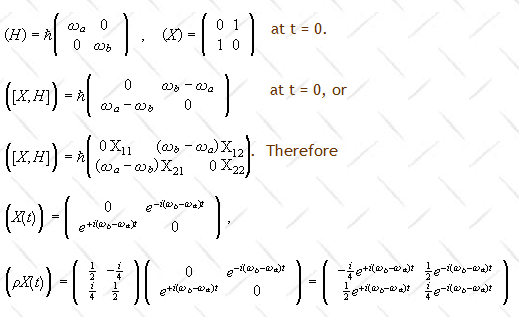

ρnp(t) = ∑kpkcnk(t)cpk*(t) (n ≠ p) expresses interference effects between the states |un> and |up> which appear when |ψk> is a linear superposition of states. ρnp(t) is the average of these interference effects. It can be zero even if cnk(t)cpk*(t) is not zero. In a statistical mixture of states the averaging can cancel out interference effects. The off-diagonal matrix elements of ρ(t) are called coherences. The populations and coherences obviously depend on the chosen basis.
Problem:Consider a simple two-state quantum system with
energy eigenvalues ħωa
and ħωb
and corresponding eigenkets |a> and |b> which are taken as
the basis elements.
(a) Write down the equation giving the time
evolution of the eigenket |a> in the Schroedinger picture and in the
Heisenberg picture.
(b) Consider a pure state, which at time t = 0
is |Φ> = 2-1/2(|a> + i|b>).
Write down the expression for |Φ(t)>
in the Schroedinger and in the Heisenberg picture.
(c) Consider a mixed state, which at t = 0
is defined by:
the system is in the state |ψ1> = 2-1/2(|a>
+ |b>) with 25% probability,
the system is in the state |ψ2> = 2-1/2(|a>
- |b>) with 25% probability,
the system is in the state |ψ3> = 2-1/2(|a>
+ i|b>) with 50% probability.
Find the density matrix ρ
in the {|a>,|b>} basis at t = 0.
(d) Explain how the density operator evolves in
time in the Schroedinger picture and in the Heisenberg picture. Find the
density matrix at time t for the mixed state in part (c) in each
picture.
(e) Consider the operator X which has
the property X|a> = |b> and X|b> = |a>. Find
the expectation value of X at time t when the system is in the
mixed state of part (c). You may use either the Schroedinger or the
Heisenberg picture for your calculations, but specify which picture you are
using.
Solution:
Let |aS> denote the state vector in the Schroedinger
picture and let |aH> denote the state vector in the Heisenberg
picture.
(a) iħ∂|as>/∂t
= H|as>, |as(t)> = U(t,0)|as(0)>
= exp(-iHt/ħ)as(0)>.
|aH> does not depend on time.
(b) |Φ> = 2-1/2(|a> + i|b>).
|Φs(t)> = 2-1/2exp(-iHt/ħ)(|a> + i|b>) = 2-1/2(exp(-iωat)|a> + i exp(-iωbt)|b>).
|ΦH(t)> = 2-1/2(|a> + i|b>).
(c)
The pure state density operator is ρk(t)
= |ψk(t)><ψk(t)|.
The density operator for a statistical mixture of states is ρ(t) = ∑kpkρk(t),
∑kpk = 1.
Here pk is the probability of being in state |ψk>.
ρ = ¼|ψ1><ψ1| + ¼|ψ2><ψ2|
+ ½|ψ3><ψ3|.
The density matrix elements in the eigenbasis of H are
ρ11
= <a|ρ|a>, ρ12
= <a|ρ|b>, ρ21
= <b|ρ|a>, ρ22
= <b|ρ|b>.
<a|ψ1> = √½, <a|ψ2> = √½, <a|ψ3>
= √½,
<b|ψ1> = √½, <b|ψ2> = -√½, <b|ψ3>
= i√½,
Therefore ρ11
= ½, ρ12
= -i/4, ρ21
= i/4, ρ22
= ½.
(d) dρs/dt = ∂ρS/∂t, in the
Schroedinger picture operators are constant in time unless they contain time
explicitly.
dρH/dt = (∂ρS/∂t)H + (iħ)-1[ρH,HH].
dρks/dt = [∂/dt|ψk(t)>S]<ψk(t)|S
+ |ψk(t)>S[∂/dt<ψk(t)|S]
= (iħ)-1[HSψk(t)>S<ψk(t)|S
- |ψk(t)>S<ψk(t)|SHS]
= (iħ)-1[Hs, ρks] = -(iħ)-1[ρks,Hs].
Therefore
dρH/dt = -(iħ)-1[ρks,Hs]H + (iħ)-1[ρH,HH]
= 0.
In the Schroedinger picture dρs(t)/dt = (iħ)-1[Hs,ρs], and in the Heisenberg picture
dρH(t)/dt = 0.
In the Heisenberg picture the density operator is
constant. Therefore the density matrix is constant.
(e) The expectation value of any observable A is <A>(t) = Tr{ρA}.
In the Heisenberg picture we have <X>(t) = <a|ρX(t)|a> + <b|ρX(t)|b>.
dXH/dt = (∂XS/∂t)H + (iħ)-1[XH,HH].
 .
.
<X> = -(i/4)[exp(+i(ωa - ωb)t) - exp(+i(ωa -
ωb)t)]
= -(i/4)2i sin((ωa - ωb)t) = ½ sin((ωa -
ωb)t).